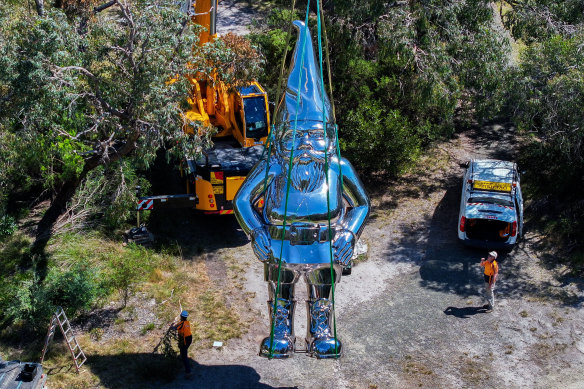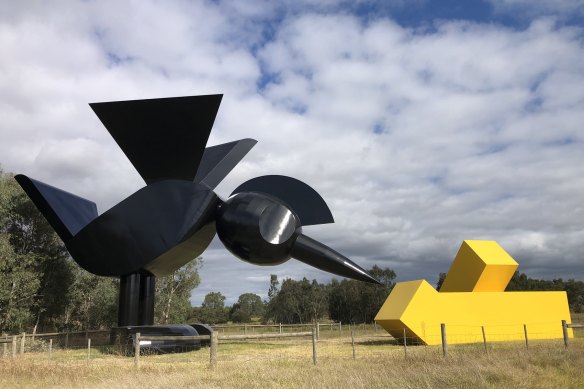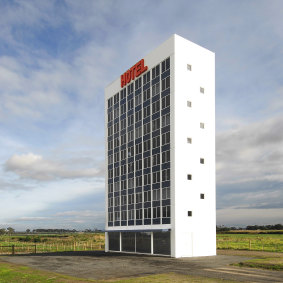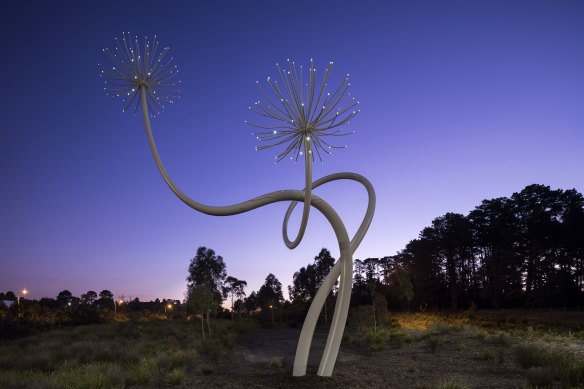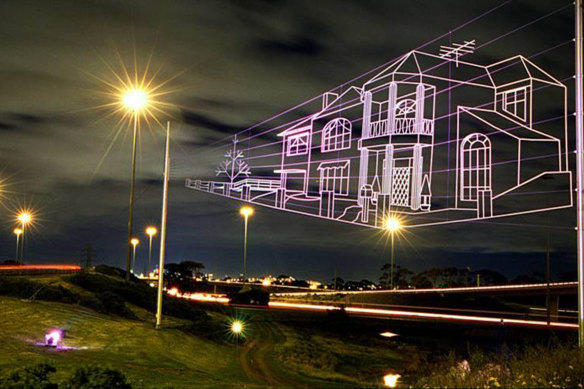Melbourne’s Chrome Gnome has a new home. What’s next for the city’s highway art?
Save articles for later
Add articles to your saved list and come back to them any time.
At first glance, it’s almost like an apparition: an enormous gnome with a shiny, mirror-like finish, standing sentry at the side of the highway. Racing by in your car, he’s gone in a flash, a moment of wonder in an otherwise stock-standard drive.
Gregor Kregar’s nine-metre-high sculpture, known variously as Reflective Lullaby, the Chrome Gnome and Frankie, has now been moved to McClelland Sculpture Park and Gallery in Frankston.Credit: Joe Armao
That’s part of the joy of highway art – before you’ve really had time to process what you’re looking at, it’s gone.
By Auckland-based sculptor Gregor Kregar, the nine-metre-high gnome, titled Reflective Lullaby, was created as part of the McClelland Commission, a public/private initiative established in 2013 between Peninsula Link company Southern Way and the McClelland Sculpture Park and Gallery.
Southern Way donates $300,000 (up from the initial $250,000) to the winning entrant for the creation of a work, and 14 pieces will be created over the 25-year period to 2037.
Nicknamed Frankie, given its proximity to Frankston, and the Chrome Gnome, Reflective Lullaby has been a regular fixture for drivers in the area. Following four years at Peninsula Link’s Cranbourne Road exit and the previous four on the corner of Moorooduc Highway and Hastings Road in Frankston, the gnome moved last week to its final stop, the nearby McClelland site.
The piece is possibly the world’s largest gnome: Kregar once tried to get Guiness World Records certification, but it was a complicated process and he didn’t persist.
Public Art Strategy, by Melbourne artist Emily Floyd.
There are quite a few roadside sculptures in Melbourne’s south-east. Emily Floyd’s Public Art Strategy on EastLink depicts a giant black bird contemplating a bright yellow worm. Standing 13 metres high, the painted steel sculpture references perhaps Melbourne’s most famous sculpture, Vault, by Ron Robertson Swann, which now sits next to the Australian Centre for Contemporary Art in Southbank, as well as Inge King’s Forward Surge, next to the Arts Centre.
Also on Eastlink, Callum Morton’s Hotel is inspired by the ubiquitous motels alongside roadways around the world, especially in the UK and the US. It has been mistaken for a real hotel, despite its scale and locality suggesting otherwise.
There’s also Panorama Station, a permanent work by Louise Paramor consisting of colourful plastic objects, boxes and receptacles of different sizes with a soccer ball on top next to a tower, on the Peninsula Link at the EastLink interchange. The artist’s statement says the 2012 work is “an assemblage of found plastic objects, which included items such as 1970s cassette towers, lampshades, spice jars and toy parts”.
Hotel by Callum Morton.
McClelland Gallery director Lisa Byrne hopes that being so well known, Reflective Lullaby will inspire people to visit. During its move, she says, a mother and a child, keen to know where the piece was going, followed the truck to the gallery.
When sited on the freeway, the gnome generated a lot of interest and love, Byrne says.
“He had a football jersey for grand finals, a COVID sticker saying ‘I’ve been vaccinated’, and [was adorned with] Christmas tinsel. The local Bunnings had a run on buying gnomes when he was installed, and there was sea of gnomes around him at one point.
“It’s a very democratic way of being involved in art and culture, quite an open way of achieving it,” Byrne says. “It really does animate our public space when we’re out and about in the world, sometimes in ways that you least expect. When [the sculptures] move, we get a lot of commentary on our socials.”
The massive gnome is now located in a beautiful bushland alcove in the sculpture park, a little way from the main gallery, so visitors will have to seek him out, Byrne says. “I’m sure there will be regular parties and picnics with him.”
Love Flower, by artist John Meade with Emily Karanikolopoulos, which has been located on Cranbourne Road for the past four years, will also move to McClelland, later this month. The latest commission, by Natasha Johns Messenger, will be installed on Peninsula Link in mid-November.
The Love Flower sculpture, by John Meade, based on an arrangement by Emily Karanikolopoulos, is designed as a gift to those travelling along Peninsula Link.
Born in Slovenia, the gnome’s creator, Gregor Kregar, moved to New Zealand in 1997. He doesn’t recall seeing much highway art in Europe. As to why he chose to make a gnome, he says they are fascinating creatures, kitsch and yet at times foreboding.
“On one side, in America and the new world, they are associated with Disney and cartoons; elsewhere they are these strange creatures, guardians of the underworld,” he says. “The word gnome comes from gnosis, which means knowing. Gnomes are also symbols of bad taste, colourful ornaments in many gardens.”
He’s also playing with the idea of a heroic, monumental sculpture and likes the idea of transforming something into a different scale, so “you add some quite poetic angle to them, thinking of them as guardians of everyday life, meditating on the world”.
Regularly re-interpreting mundane things, he aims to create “something that operates between the ridiculous and the sublime”. Inspired by his adopted home New Zealand, one of his sculptures involved using live sheep wearing colourful woolly jumpers.
Other highway art in Victoria includes the Brimbank Wind Socks on the Western Ring Road, created by the late Jim Sinatra and Phin Murphy. The 19 large windsocks are designed to reflect Brimbank as the most culturally diverse of the west’s local government areas, and the flags of the 96 nationalities represented in the area create the colour palette used. There is also a Melton equivalent, inspired by similar ideas.
House in the Sky public art by architects Brearley Middleton
On the Westgate Freeway near Altona and Laverton is House in the Sky, created by Brearley Middleton Architects, now known as BAU. Installed in 2002, it was the initiative of five western metropolitan councils, sponsored by the Department of Infrastructure and guided by VicRoads.
The much-loved Cheesestick – more grandly and officially known as Melbourne International Gateway – must also rate a mention. It was designed by Denton Corker Marshall and is located on CityLink, providing a memorable first piece of art that visitors to Melbourne see when approaching the CBD from the airport.
Find out the next TV, streaming series and movies to add to your must-sees. Get The Watchlist delivered every Thursday.
Most Viewed in Culture
From our partners
Source: Read Full Article
